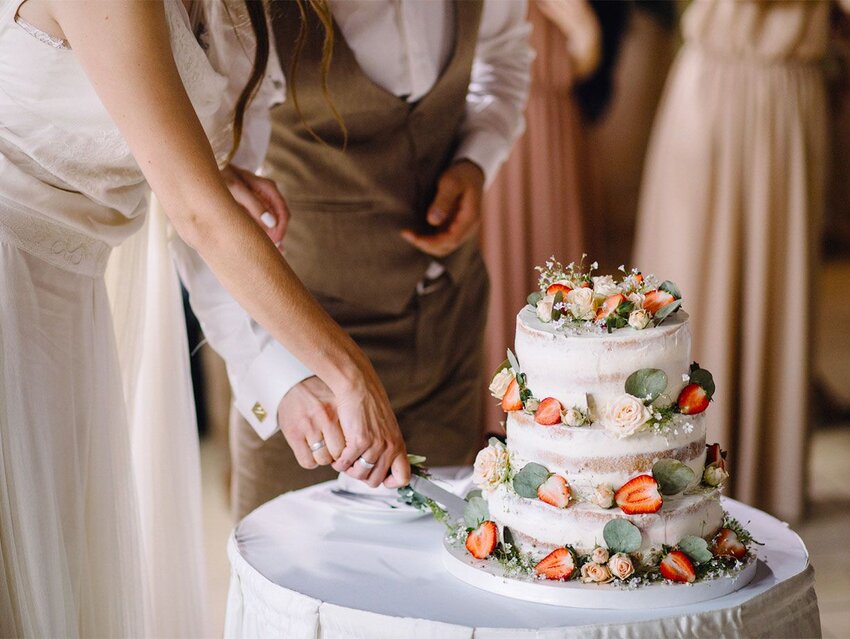With wedding season upon us, it’s time to take a look at some of the lingo that makes the big day possible. As weddings become more creative and personalized, some of the more traditional elements are falling away, while some ceremonial features are finding new life. To help you navigate your next nuptial event like a seasoned guest, we’ve rounded up some of the most essential words of the season.
Altar
Derived from Old English, historically, an altar was used for religious purposes during sacrifices to the gods. Fortunately, it has a happier connotation today, especially for weddings. It simply refers to the place where the couple stands during the ceremony (religious or secular). Different cultures and religions have various options for wedding altars. At Jewish ceremonies, it is called a chuppah, meaning “blanket,” because a piece of cloth covers the couple for protection. At a Hindu ceremony, the mandap is a four-post altar that represents the four mantras of a fulfilled life. At non-religious ceremonies, the happy couple might use an arch to symbolize entering a new phase of life, or a trellis or gazebo as a decorative element.
Blusher
A blusher is a short wedding veil (usually attached to a longer veil) that is worn over the (blushing) bride’s face. Historically, it was worn by the bride until she was presented to the groom. It represented modesty and purity and was also thought to ward off evil spirits. It’s a traditional element that is increasingly being left out of modern bridal ensembles, but still functions as an accessory or as protection from the elements at outdoor ceremonies.
Black Tie
This dress code designation became popular in the 1930s as daily fashions were becoming more casual. Generally, black tie is reserved for very formal, evening weddings. Guests should be thinking of floor-length gowns and tuxedos. There is technically one category of dress even fancier than black tie — white tie — but modern couples normally don’t choose this.
Bonbonnière
Why say “Jordan almonds” when you could call it a bonbonnière? In 19th-century Europe, aristocrats would send their wedding guests home with a small gift called a bonbonnière (bomboniere in Italian). The term comes from the French word bon-bon, or sugary confections. Today, this word might be used as a fancier way to describe wedding favors.
Cocktail Hour
It’s not always strictly 60 minutes, but this is a modern wedding term that describes the time between the wedding ceremony and the reception. During this time, the wedding party might take pictures, while guests mingle, have a cocktail, and enjoy some hors d’oeuvres. The phrase “cocktail party” has been around since at least 1907. The word “cocktail” to describe a mixed drink was first documented in 1806, but its origins are murky, and might involve a horse with a docked tail, or possibly the French word coquetier, which means "egg-cup."
Corsage
The Old French word corsage meant “bust, trunk, or body,” but today, the word is used for an arrangement of flowers worn as a fashion accessory. Typically, corsages are worn by female-identifying members of the family during the wedding. They can be pinned on or worn on the wrist. The counterpart for male-identifying members of the family is a “boutonniere” — from the French word bouton, which means “button.”
Elope
The word “elope” comes from Middle Dutch (ont)lopen, meaning "run away." Today, not all couples who elope are running off for secret weddings. The term is also used to describe small, private weddings with just the couple, an officiant, and a few close witnesses.
Hors d’oeuvres
Pronounced “awr-durv,” this is a French term for “appetizers.” At weddings, these are usually served during the cocktail hour while guests are socializing. The phrase comes from hors (outside) + de (from) + oeuvre (work), essentially meaning “apart from the main work” (apart from the main meal).
Fiancé/Fiancée
These are the words used to describe the couple during the time of engagement before the wedding. A male-identifying partner is a fiancé and a female-identifying partner is a fiancée. This spelling rule comes from French, where the feminine version of the word requires an extra “e.” The term comes from the Latin word fidus, meaning “faithful.” In modern times, it has taken the place of “betrothed” as a noun.
Processional
The word was first used in 15th-century churches to describe a book of hymns and directions used during religious ceremonies, but it became the traditional “Here Comes the Bride” moment. It refers to the group of people that walks down the aisle at the beginning of the wedding ceremony. The order of procession, the music, and other customs vary greatly depending on culture and religion. In modern ceremonies, many couples personalize the processional with music choices and adding participants such as children and pets.
Receiving Line
This is the counterpart to the processional. A receiving line occurs when all the wedding guests line up as the recessional (the group of wedding participants that walks back down the aisle) is leaving the ceremony. In ancient tradition, throwing rice symbolized a marriage of prosperity (and many children), but other after-wedding projectiles included figs, coins, and candy. Today, fun receiving-line customs include throwing flower petals or birdseed, to releasing butterflies or blowing bubbles.
Sweetheart Table
As its name suggests, a sweetheart table is a small table that is exclusively for the newlyweds during the reception. This modern invention is in place of a “head table,” which, traditionally, includes the new spouses and their bridal party. The word “sweetheart” has been used since the 16th century as a synonym for “loved one.”
Featured image credit: VAKSMANV/ iStock

